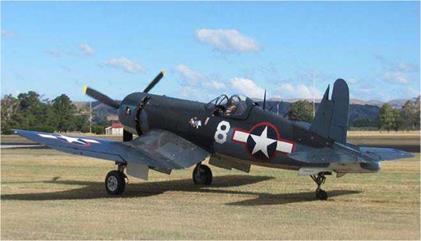Propulsors
Other types of propellers still under development since the 1970s are the Propfan and Propulsor. Unlike the Propfan, which is a relatively new idea, Propulsors have been around for many years. A Propulsor is simply a propeller mounted inside a shroud. Although it has several advantages over conventional un-shrouded props, it has never been greatly utilized by aircraft designers, because of its suitability only for low-speed operations.
The Propulsor can trace its origin as far back as 1910, to the Bertrand Monoplane of French design. It had a single-engine driving a tractor and a pusher propeller, one at each end of the shroud. This was followed in 1932 by the Italian built
|
One of many flying examples of the Chance Vought F4-U Corsair taxiing out for take-off. |
Stipa-Caproni, with a 120 BHP DeHavilland Gypsy III engine and Propeller, which were both mounted inside the shroud, which was a part of the fuselage. A more recent example of a Propulsor equipped aircraft appeared in 1996, in the form of the experimental Bell X-22A with four turbine engines driving separate tilt-vector propellers mounted inside shrouds. The US/German, VFW Rhein Flugzeubau/Grumman American joint venture Fanliner with two seats and a pusher Propulsor was another example. The Brooklands/Edgeley Optika from the UK, designed for the observation role, was showing good prospects for being a commercial success until ten of the twenty aircraft built was destroyed in a factory fire. Some could possibly be still flying. However, prior to this loss, the prototype’s first flight was made on 14 December 1979. The five-blade fixed-pitch propeller is powered by a 200/210 BHP Lycoming engine, giving the aircraft a cruise speed of 57-108 knots. Due to the propulsor, it is said to be the world’s quietest aircraft. Present day airships, such as those built by Airship Industries of the UK, have relatively low cruising speeds and are ideally suited to being propelled by the Propulsor type of engine












